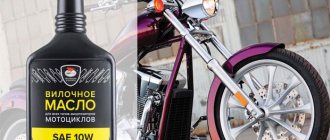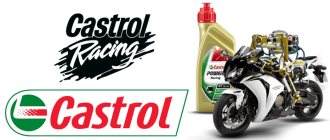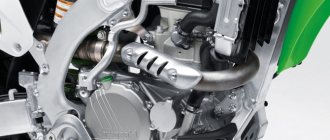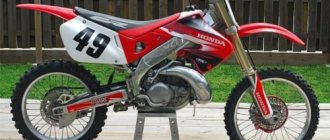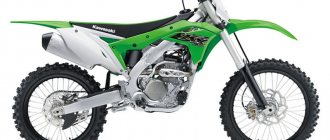A pitbike, although small, is a real motorcycle that requires proper care and maintenance for its service to be long and impeccable. Those owners who are worried about the viability of their iron horse, but do not have enough experience, often ask the question on forums: “How often should you change the oil in a pit bike?” Since this topic is important and always relevant, in this publication we will also examine it.
What to consider when choosing oil for a pit bike
To choose the right liquid, several factors should be taken into account.
Engine type
Traditionally, such equipment uses 4-stroke engines with a volume of 50 to 165 cc/cm. but there are also two-stroke models. Depending on the type of power plant, the type of lubricant should be selected.
Manufacturer's recommendations
The most accurate factor is the manufacturer's tolerance. The motorcycle passport usually contains complete information about the viscosity, type and tolerances of the lubricant.
Season
Usually a pit bike is used in the summer. But there are some thrill-seekers who ride all year round. This is where nuances arise.
- In summer, when the temperature outside rises above +30 degrees Celsius, the standard viscosity (10W-40), recommended by most factories, is not relevant. The liquid begins to simply boil away from overheating. Here you should select lubricants with increased high-temperature viscosity.
- In the spring-autumn period, at air temperatures from +10 to +25, the most common viscosity for pita 10B-40 is useful. The motor will operate in nominal mode and without overheating.
- With the arrival of cold weather, you should definitely switch to less thick lubricants. In light frosts, you can use formulas like 5W-30, most common for scooters and mopeds. If the driver is completely extreme and drives in frosts worse than -10, it would not be a bad idea to use special oils for snowmobiles with a density of 0W
Tolerances and specifications
Typically, manufacturers recommend pouring oils from the API SJ group and similar ones into pit bikes. This is due to the simple design of the power plant and the absence of sophisticated exhaust cleaning systems.
There are also recommendations for lubricant base. In most cases, it is semi-synthetic, but mineral water should be poured into damaged engines due to its higher viscosity.
Making things easier for bikers
Motocross is a rather unusual sport, but it has found many supporters in the Russian Federation. Among them is the Pit Bike Club team. We know about all the technical features that a sports motorcycle has and take them into account when forming our assortment. We would like to draw your attention to the achievements of the chemical industry. When selecting motor oils for sale, we try to ensure that they contain a special component. It optimizes viscosity so that the product is adapted to winter and summer weather conditions. Here you will find the following brands:
- ENI IRIDE 4T - semi-synthetic. Available in liter packaging. Often used on 4T engines (volume 110-140 cm³).
- MOTUL 7100 4T 5 W-40 - synthetic. It contains esters that improve the quality of motor oil. The condition of the engine and gearbox is also much better, and the bike drives just great. This oil does not go on sale immediately; first it undergoes multiple tests.
- MOTUL 4T 7100 10W-40 - synthetic. This material is especially popular among pit bike owners. It is recommended to purchase it for a sports motorcycle with an engine capacity above 150 cubic centimeters.
Study the Pit Bike Club catalog - updates appear regularly in the motor oils section. Contact managers via chat or phone. We know the sport of motorcycling and its peculiarities and carefully check the products we present. Any question you have when choosing motor oil will be resolved very quickly. We have a mechanical engineer who knows all the models of sports motorcycles used today in cross-country racing.
Why can it be very profitable to buy motor oils offered by Pit Bike Club? Because we not only guarantee the quality of the product. Partner suppliers give us a discount, and therefore customers are pleased with the low price.
What oil is best to put in a pit bike?
Today, the pit bike has become almost the most popular vehicle among motorcycle equipment. They sell like hot cakes on the market. But there is no such equipment that you can just buy and ride all your life.
Pit bikes need timely maintenance, such as changing the engine oil. This procedure is very important, since the four-stroke engines produced today are more advanced and powerful than earlier models. Excess or lack of oil negatively affects the operation of the pit bike, so you must know the exact volume for the engine of a particular model. As a rule, this is 800-900 ml.
In order to change the engine oil, the first step is to unscrew and remove the dipstick, which also acts as a filler plug. This is necessary so that some air gets inside, which will make it easier for the oil to exit through the drain hole.
Maintenance of new equipment
Any new equipment purchased from a warehouse in original packaging or in an assembled state is not suitable for full operation. Despite the shine of the parts and the clear sound of the engine, your equipment needs to be serviced and undergo zero maintenance!
What is zero maintenance or why can’t you ride immediately after purchase?
Zero maintenance is a must to ensure the stable performance of your motorcycle over a long period of time. Zero maintenance is a set of actions aimed at putting all elements in the design of equipment in order in a state suitable for use. Most often, zero maintenance is offered when purchasing equipment in a store as an additional service, however, with the correct position of hands on the body, any owner can prepare his horse for the season on his own.
Necessary purchases: maintain your equipment correctly!
Of course, buying a pit bike, cross-country motorcycle or ATV implies not only the purchase of equipment, but also the means necessary for care and maintenance. In order for your motorcycle to serve faithfully, it is recommended to purchase the following set of “extras” - additional devices:
NECESSARILY!
WE RECOMMEND:
A motor watch is not a mandatory accessory for the rider, but its presence will allow you to quickly determine the level of wear and the need for an oil change. The engine hour is a unit of measurement of the actual engine work per astronomical hour, thanks to which you can quickly assess the internal condition of the motorcycle without disassembling the device.
There are several types of watches, but the functional purpose of all devices is the same.
Installing the engine clock does not take much time and does not require disassembling the pit bike. To install the device, you need to connect one end of the cable supplied with the engine clock to a special connector on the sensor, and wrap the other end near the cap on the engine spark plug. When the engine starts, the clock will start running and start reporting.
A very relevant accessory when buying a pit bike or motocross motorcycle, such a device will not only protect your hands in case of a fall or while riding through bushes or mountain ranges, but will also ensure the safety of the levers. Due to the high cost and low level of strength of the levers, hand protection will quickly pay for itself and become an indispensable item for the rider.
Every self-respecting rider should have a set of consumables in the event of an accident or breakdown of the motorcycle. The list of necessary items includes:
The cost of these spare parts is not high, and it is best to buy them immediately when purchasing equipment in order to later save yourself from wasting time searching for and purchasing them.
Maintenance of new equipment.
1.Changing the engine oil.
When purchasing new equipment, the engine is already filled with motor oil, but this oil is used for transportation and serves to prevent corrosion from appearing on the internal parts of the engine due to long transportation and subsequent storage of the equipment in the manufacturer’s warehouses.
We strongly recommend not to use your equipment in full mode with this oil.
Changing the engine oil should be done after the engine has warmed up to operating temperature, and before changing the oil, especially for the first time, it is recommended to drive for 10-15 minutes actively, changing gears. This procedure is necessary so that all kinds of chips and metal debris from new parts are separated and drained from the engine along with the oil.
During the break-in of new equipment, the engine oil needs to be changed up to 4 times , this is where engine hours come in handy
The oil should be exclusively for motorcycles. The amount of oil in the engine is specified in the instructions for the equipment.
Important! After draining the oil, you must tighten the drain bolt correctly. The thread on this element often breaks off when trying to tighten the bolt tightly, which leads to the need to replace components, up to half of the crankcase. After adding fresh oil, be sure to check the fluid level. The oil level will be checked with a special dipstick in a strictly vertical position of the motorcycle: underfilling the oil during break-in can lead to rapid wear of parts and engine breakdown.
2.Air filter maintenance
Particular attention should also be paid to the air filter. Dust or even small debris getting into the carburetor is a fairly common problem, resulting in poor engine performance. In order not to have to worry about cleaning the carburetor and adjusting the valve clearances, it is necessary to promptly impregnate the air filter with a special composition. The filter must be impregnated as needed (visual contamination and lack of impregnation on the filter)
Note! Under no circumstances should the filter be soaked in regular oil or washed with gasoline.
3.Chain care: cleaning and tensioning
The chain on a motorcycle is a place of constant maintenance. In order to protect yourself from a sudden chain drop or break, it is recommended to regularly check its tension - the chain should sag no more than two fingers.
Often, when buying a pit bike, the chain on the motorcycle is not set up correctly - it either sag or is overtightened. Operation in both cases threatens to cause the chain to fall off while moving, which will lead to the sprockets grinding down or breaking.
How to change the oil on a pit bike correctly?
Here are step-by-step instructions:
- It is necessary that a little air enters the engine, which is necessary for better oil exit through the drain hole. For this to happen, you need to unscrew and remove the dipstick.
- It is necessary, using a 17-mm open-end wrench, to slightly loosen the drain bolt located in the lower part of the crankcase; this bolt can be seen through the hole in the crankcase protection.
- Place a container with a capacity of at least 1 liter under the engine and remove the plug completely. You just need to do this very carefully so as not to get dirty with oil or drop anything into it.
- Leave the pit bike for 25-35 minutes, allowing the oil to drain into the container by gravity, and then tilt the pit bike from side to side several times so that all residues come out.
- After there is no oil left inside, the drain bolt is put in place and tightened.
Some motorists believe that it is not at all necessary to carry out such a procedure - you can simply add fresh oil, and in this way it will be renewed. This is a fundamentally wrong decision, because... various sediments and impurities do not disappear anywhere, but only spoil the quality of fresh oil and impair engine performance.
How to check the oil level on a pit bike?
After the used oil has been removed, new oil must be added. Unless you want to “mothball” your pit bike until spring, for vacation or for other reasons. In this case, there should be neither too much nor too little oil, because in both cases the operation of the engine can be disrupted. The manufacturer should indicate exactly how much oil your pit bike requires in the accompanying documents, but still, especially at first, it is better to make sure of its optimal quantity.
How to check the oil level on a pit bike? It's quite simple to do this:
- After the oil is poured, you need to insert the dipstick and plug, but do not tighten it.
- Make sure that the pit bike is not skewed, but is level.
- Pull out the plug and dipstick and see to what level the oil reaches - it should reach the middle of the ribbed surface.
- If this is the case, then return the plug with the dipstick to its place, tighten it completely and start the engine. If not, then pour or add the required amount accordingly.
PRECAUTIONARY MEASURES.
Always wear a safety-compliant helmet, eye protection, and other protective equipment when riding a motorcycle.
Operating a motorcycle without a helmet increases the risk of serious injury or death in a crash.
Driving a motorcycle is different from driving other vehicles, including cars. Even during normal maneuvers such as turning, driving up hills, or driving on uneven surfaces, a collision or vehicle rollover can easily occur if safety precautions are not taken.
A motorcycle is a vehicle of increased danger - driving a motorcycle while under the influence of alcohol or drugs is prohibited.
Always use extreme caution and drive slowly when driving in unfamiliar terrain. Be prepared for changes in terrain conditions when operating a motorcycle.
Do not operate your motorcycle on rough, slippery or damaged roads until you have learned and gained the practical skills necessary to control your motorcycle under such conditions.
Never select too high a speed unless it is suitable for your skills and operating conditions. Always select your speed according to road conditions and your experience.
Recommendations for choosing motorcycle oil
The type of fluid chosen directly depends on the type of engine. He can be:
The second reason for making the right choice is precisely the classification of motor oil that we presented above. This is manufactured using three different technologies, which result in a mineral, semi-synthetic or synthetic material.
There are also not recommendations, but rather requirements on how to choose a product. In 1998, the Japanese standard JASO T 903 was developed, which specifies all the minimum and maximum permissible technical characteristics of fuels and lubricants for four-stroke motorcycles. One of the main criteria that distinguished the product from machine compounds was the behavior of the engine with a wet clutch. And if the liquid has not been certified according to JASO requirements, then it cannot be recommended for use by motorcycle manufacturers.
Below we will show other parameters that determine which oil is best to pour into a motorcycle.
The lubricating function is the main one in motor oil, due to which the adhesion of rubbing parts to each other is reduced, which slows down their wear and increases the service life of the engine. But during operation, the lubricant properties of the oil deteriorate. This happens as a result:
- the natural process of aging and oxidation of oil;
- ingress of coolant;
- mixing with fuel;
- contamination with soot and/or wear and corrosion products of engine parts.
Accordingly, if you do not change the oil, the engine will begin to wear out, which will lead to its rapid failure.
When is the deadline?
Next, we’ll look at how to find out whether an oil change is needed on a pit bike, and how often such tests should be carried out.
In general, in the technical documentation for any equipment, the manufacturer indicates the recommended periods for oil changes, but most owners of their iron horses take the terms twice as short, because It was noticed that with this approach, engines work properly for much longer.
In order to make sure that an oil change is necessary, you can perform several tests:
- The easiest way is to look at the color of the oil. If it has become so dark that the dipstick is not visible through it, then it needs to be changed accurately and as quickly as possible.
- You need to start the bike so that the engine warms up, then remove the dipstick and shake a drop of oil onto the paper. After 15-20 minutes, see what happened: if the oil has spread over the paper, it means it can still be used; if it has been absorbed in one place, forming a dirty circle, it means it needs to be replaced.
- Purchase a set of express tests that will quickly and easily determine such important indicators of gasoline as viscosity, flash point, alkaline-acid level, amount of water, sediment, metals, ethylene glycol.
- Go to a special service where oil analysis according to the above indicators will be carried out by professionals.
Mileage and mixture replacement
The car dealer indicates the period of scheduled maintenance; in my car, the engine fluid must be replaced according to the regulations every 15 thousand km. Let's figure out how many engine hours the engine will last when driving around the city and the engine of a similar car, the owner of which will drive mainly on country roads. Let's calculate whether the declared mileage corresponds to the actual engine oil change period.
The engine hours indicate the duration of operation of the power unit at rated speed; the engine hour is equal to one hour of normal operation of the drive. When performing calculations using engine hours, you do not take into account the operating conditions of the power unit (with a loaded engine, the engine fluid wears out faster and requires replacement).
According to my car's on-board computer, the average speed is 26 km/h. This is a real figure: when getting to work, I have to stand in traffic jams for 40 minutes; in the evening, under similar conditions, the car sits idle for 1.5 hours. With such a variable load, the operating mode of the power unit is close to extreme operating conditions, the drive heats up, the engine mixture experiences a colossal load - at high temperatures it changes its properties. Obviously: you will have to change the fluid before the recommended mileage.
Based on the facts, let’s take 15 thousand km for calculation, divide the indicated mileage by the average speed of the vehicle, we get 15,000/26 = 576 engine hours. This takes into account the time spent in traffic jams, plus warming up the engine in winter (the on-board computer starts counting from the moment the drive starts).
According to the calculations, we obtain the values, put them in table 1
Table 1. Relationship between engine hours, speed and mileage
26
| Speed, km/h | Mileage, thousand km | Engine hours |
| 15 | 576 | |
| 10 | 385 | |
| 8 | 308 |
The average speed in the city is close to 30 km/h, a similar car on a country road will cover a distance 3 times greater, and on the highway the car moves 70 km/h. Both motors will do the same amount of work. The speedometer of the first car will show mileage much less than that of the second car. It is worth considering how realistic the figure indicated by the dealer for replacing the lubricant mixture is.
Two-stroke engines
This is often oil for a motocross motorcycle (enduro, pit bike) or for the old Soviet Izh. Also, two strokes are often enough to quickly accelerate a 125cc scooter or motorbike. There are cheap synthetics and very high-quality synthetics that are worth filling, for example, for motocross or other intense wear. For example, 800 2T Factory Line Off Road Motul.
What quality indicators are required for such fuels and lubricants? First of all, this is resistance to soot formation, as well as the amount of smoke emitted during combustion, because the gasoline-oil mixture burns along with the fuel.
There is a division of oils into categories, here are the labels suitable for them:
But there is also a Japanese classification, according to which they distinguish:
Why shouldn’t you pour 4-stroke engine oil into such engines? Because they usually contain a large amount of additives that burn poorly in the fuel tank, leaving carbon deposits. This pollutes your device a lot, but, of course, you will be able to travel 100-200 km.
19 athletes from Grodno will take part in the race:
Up to 50 cm3: Rusetsky Mark starting - No. 59 Chegodaev Daniel - No. 11 Malashenko Fedor - No. 7 Up to 65 cm3: Ivanova Diana - No. 153 Up to 85 cm3: Volovich Daniel - No. 741 "Hobby": Kozhalo Pavel - No. 299 Semenov Andrey - No. 11 " Veteran": Lupach Vitaly - No. 17 Savko Alexander - No. 74 "ATV SPORT": Dmitrovich Alexander - No. 777 Parfenchik Alexander - No. 9 "Motorcycle with sidecar": Kuts Andrey, Bakurevich Vladimir - No. 77 Lagun Sergey, Artsukevich Anatoly - No. 15 Sidnev Oleg, Dektyarev Sergey - No. 17 Povidayko Vadim, Getsman Sergey - No. 9
Motocross is just beginning to make a comeback. Come support the Grodno champions!
How to choose oil?
The choice of oil type depends on the type of equipment, its newness and many other factors. For example, for engines with a long mileage, it is better to take mineral oil, because... it creates a thicker lubricating layer and restores compression, highly accelerated engines prefer synthetics, and the ideal option for most pit bikes is semi-synthetic with a viscosity of 10W40.
In this publication, we tried to fully disclose all aspects of engine operation under different conditions, so that you never again have questions about how often to change the oil in your pit bike and why you need to do it.
(2 ratings, average 5 out of 5)

